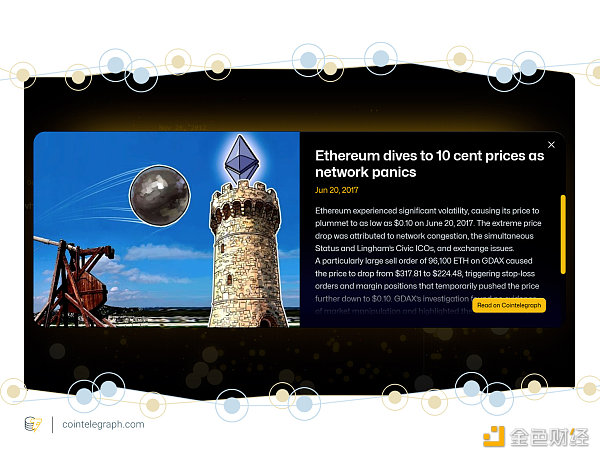Source: CoinTelegraph; Compiled by: Tao Zhu, Golden Finance
In this article, we will venture through one of the most transformative periods in crypto history, the Initial Coin Offering (ICO) boom.
In early 2017, ICOs took the cryptocurrency space by storm, enabling thousands of new blockchain-based projects to quickly raise large amounts of money by selling pre-issued tokens directly to investors. Projects issued tokens in exchange for funds to launch new networks and decentralized applications (DApps).
Related content:
Tracing the History of Cryptocurrency (I): Satoshi Nakamoto's Response to the Financial Crisis
Tracing the History of Cryptocurrency (II): The Joining of Ethereum and the Surge of Bitcoin
What is ICO?
ICO is a token sale that combines the initial public offering (IPO) model commonly used in the traditional financial world with crowdfunding to sell tokens to raise funds for blockchain-based projects.
It is worth noting that while the ICO boom was considered a period of huge returns for projects and investors, it was also rife with exit scams and rug pulls, which later attracted close attention from regulators and investors such as relevant financial authorities.

The largest ICOs during the boom
Although the ICO boom was fraught with various types of regulation and financial turmoil, it laid the foundation for the launch of some of the largest projects in the crypto space today, including Ethereum, EOS Network, Chainlink, Filecoin, Tezos, and Telegram (TON).
The largest ICO was conducted by a private company called Block.one, the creator of the EOS network. EOS raised a staggering $4 billion in 2018.
The second largest ICO was conducted by Telegram, which raised $1.7 billion. However, unlike many other ICOs that were offered directly to retail investors, Telegram's ICO was largely restricted and therefore limited to private investors with significant capital.
The decentralized storage network Filecoin was the third largest ICO, raising over $257 million in 2017.
Ethereum's Role in the ICO Boom
Ethereum itself was initially funded through an ICO, raising a total of $18 million between July 22 and September 22. On January 2, 2014, investors in the Ethereum ICO exchanged Bitcoin (BTC) for Ethereum (ETH), selling more than $2.2 million worth of Ethereum within 24 hours of the ICO going live.
The vast majority of ICOs between 2017 and 2018 took place on the Ethereum network, where smart contracts allow developers to launch new tokens and launch protocols more easily than any other available blockchain network.
The Ethereum network allows developers to create new ERC-20 tokens and automatically distribute them to investors once a funding threshold has been reached. These projects would then be governed by a DAO.
The functionality provided by Ethereum led to a rapid increase in the price of the network’s native token, ether, from around $10 in January 2017 to a peak of nearly $1,400 the following January.
Similarly, during the ICO boom, Ethereum’s use increased, and ERC-20 tokens became the industry standard, laying the foundation for Ethereum’s continued prominence in today’s crypto ecosystem.

ICO Boom and Legal Woes
While many projects raised funds from ICOs for legitimate reasons using newly raised funds, there are thousands of projects that are either poorly planned or outright fraudulent, relying on hype and sketchy marketing strategies with no real roadmap or legitimate development plan.
It was the increasing number of these projects that were revealed to be illegal that attracted the attention of the U.S. Securities and Exchange Commission (SEC).

Regulators first began to focus on issues related to ICOs in 2017, following an investigation into a 2016 ICO by the organization “The DAO” and the conclusion that the related sales were illegal and constituted an offering of unregistered securities.
In this precedent, the SEC took legal action against Block.one, the parent company of the EOS network, ordering them to pay a $24 million fine. Likewise, the agency also ordered Telegram to pay an $18.5 million fine and return a staggering $1.2 billion to its ICO investors.
Telegram was forced to abandon the project as the native TON tokens were deemed securities. The TON network was later saved by the developer community, as the project’s codebase was open source.
Tracking the History of Cryptocurrencies!
Despite regulatory scrutiny, ICOs have played a key role in the fundraising process for some of today’s most important blockchain projects.
Notably, the ICO boom laid the foundation for Ethereum’s dominance in today’s crypto ecosystem, establishing the ERC-20 token as an industry standard and significantly increasing developer usage of Ethereum.
In the next article, we will delve deeper into the crypto winter of 2018 and explore the most important elements of Ethereum’s evolution at the same time.
 JinseFinance
JinseFinance
 JinseFinance
JinseFinance Wilfred
Wilfred JinseFinance
JinseFinance JinseFinance
JinseFinance Brian
Brian Beincrypto
Beincrypto Cointelegraph
Cointelegraph Bitcoinist
Bitcoinist Cointelegraph
Cointelegraph Cointelegraph
Cointelegraph